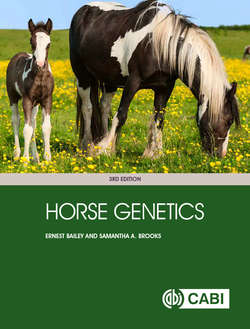Читать книгу Horse Genetics - Ernest Bailey - Страница 34
На сайте Литреса книга снята с продажи.
Asiatic Wild Asses
ОглавлениеThe taxonomy of the Asiatic wild asses has a considerable degree of uncertainty. They are difficult to study because of their distribution in remote locations throughout Asia, and their scarcity both in zoo collections and in the wild. While popularly referred to as kiangs, onagers, and kulans, the existence of multiple species and subspecies of Asiatic wild asses is a matter of continuing research and discussion (Groves and Ryder, 2000). The kiang is occasionally described as composed of three subspecies, E. kiang kiang, E. k. holdereri, and E. k. polyodont (Fig. 3.6). Table 3.1 shows the results from karyotyping the kulan (E. h. kulan), the onager (E. h. onager), and the kiang. The kulan and onager (i.e. hemione) karyotypes are similar to each other while kiangs possess between two and four fewer chromosomes and are genetically distinct, based on studies of mitochondrial DNA (Oakenfull and Ryder, 1998; Oakenfull et al., 2000). Variations within the kulan, onager, and kiang populations typically involve Robertsonian rearrangements of chromosomes (Ryder and Chemnick, 1990). Mitochondrial DNA sequence comparisons of E. h. kulan and E. h. onager showed minimal differences and led the authors to raise questions about designations of these animals as separate subspecies (Oakenfull and Ryder, 1998; Oakenfull et al., 2000). For more information about the status of Asiatic wild asses, see Shah et al. (2008) and Moehlman et al. (2008b).
Fig. 3.6. Kiang (E. kiang) (picture provided by Zoological Society of San Diego).
